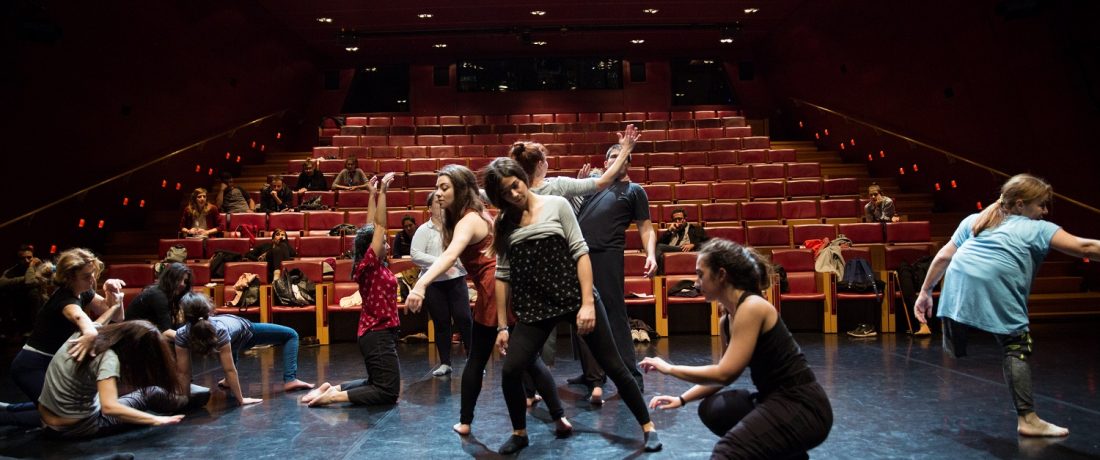
Movement Translation Workshop
TARGET GROUP
adults with and without disabilitiesPARTICIPANTS
18-22DURATION
1 hour 50 minutesORGANIZATION
Stopgap Dance CompanyGoal - Essential question
To give dancers the tools they need to translate movement from different bodies. It is important to acknowledge that everyone has a different body and can translate the movements in their own way. Translating is not just one way; a standing dancer can translate movement from a wheelchair dancer and then this process can happen again in reverse so that a version can be found for all.
Preparation
It would be useful to have a pre-prepared phrase and articulation exercise that can be taught to the group.
Warm up (10 minutes)
Mobilization-based warm up using open instruction to prepare the whole body for movement. Explore both whole body movement as well as fine detail. You can use a focus on energy, intention, quality or any words related to the movements that you will use in the next section. Include something to get the heart rate up.
Outcome: Prepare the body to be responsive and ready to translate movement.
Translation streaming (30 minutes)
Travelling from one side of the room to the other, give examples of movement which each dancer has to translate for themselves, each time focusing on a different area of translation.
1. Flow of energy and intention of movement.
2. Looking at the spine and direction.
3. Quality and Rhythm
4. Details and focus.
With each movement idea, give time for the dancers to experiment and find their own translations. Feel free to pull out interesting and unique translations for the whole group to watch and try. Encourage them to challenge themselves, and to find many versions of the movement, before choosing their preferred option. The version they will choose at the end should be the one that best captures the specific area, is recognizable as a translation of the original movement and challenges them as a dancer. Ask the dancers to remember their translations as they go. Once each dancer is happy with his/ her translation, combine all the previous four movements into one longer movement sequence.
Progression: After they have put all the movements together, split them into groups to dance the sequence together. Although their movements may be different, it is important that they dance together progressing through the sequence at the same time and find a sense of group timing.
Outcomes: To open up movement possibilities through learning about translation skills.
Articulation (15 minutes)
An articulation exercise focusing on detail and precision, designed for one person in the group with extra challenges for those who desire. Think specifically about one of the dancers, who might have a different physicality from the rest of the group. What do they need to warm them up and develop their skills? Be clear about the intention or purpose of each move to allow others to find relevant translation where necessary.
Outcome: Practicing skills learnt from translation travelling.*
*An example of this can be found in the iDance Learning Corner, Digital Material under Hannah’s Articulation by Stopgap Dance Company.
Osmosis task (20 minutes)
Ideally in groups of three, each person starts with a different role – as a dancer, an echo and an observer. Whilst one person dances, the other person watches and tries to capture the essence of their movement. The person watching then dances their echo of the first person’s movement. The Observer watches everything and then feeds back what they have seen to the dancers. Then rotate the roles so that each person has a chance to take on every role.
Progression: Giving each person the opportunity to create a short solo based on what they have discovered throughout this task. Several of these can be used to teach the group how to create a full phrase.
Outcomes: Tuning in to the specific details of another dancer’s movement and physicality.
Merging movement to create unison (30 minutes)
Start by teaching the group either a pre prepared phrase or one using the material from the previous task and give them time to find their own version using all the skills worked on during the streaming. Split the whole group into smaller groups and choose someone to become a choreographer. The choreographer looks at each translation and then the group as a whole and finds a way to merge the movements and details, creating a phrase for the group to dance together.
Outcome: Learning movement together and applying details from individual phrases.
Cooldown (5 minutes)
Gentle cool down, catering for what the group needs.
